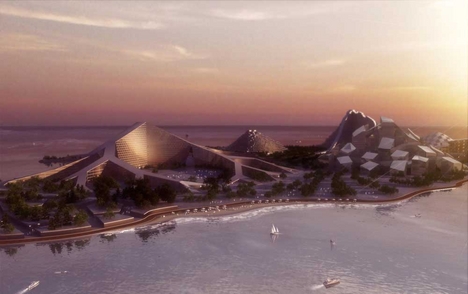
One million square meters. That is the program BIG has added in a masterplan to a small island in the Caspian Sea called Zira. Being located right for the coast of Baku, the capital city of Azerbaijan, the island is expected to attract massive crowds. To accommodate the million BIG resided to a metaphor that is all about mass: the mountain.
For the island BIG proposes a set of seven different buildings, whose form is derived from seven peaks of Azerbaijan. Each measuring about 130.000 square meters, the buildings are huge. Monstrous almost. Everything is set in place to only reach one goal: to build a carbon neutral neighborhood. In an emerging oil-country.
BIG aims to reach the ‘zero’ by focusing on the sun, the wind and the water. Pretty much all there is on an island. The sun and wind are used to generate energy, the water is recycled. Heat pumps connected to the Caspian Sea warm and cool the buildings. The necessary windmills are projected in the sea, not on the island itself. Just like the concept OMA just presented for the area surrounding the North Sea. The sea once again is the new frontier.
The question the design by BIG poses is whether or not a sustainable environment benefits from dense, mid-rise building complexes. The earth is rapidly being populated by freestanding towers. It is the one building typology that is uncontested. In the face of sustainability, is that position about to crumble?
What fascinates me most about the masterplan by BIG is that the buildings actually haven’t been inspired by the seven mountains of Azerbaijan at all. When browsing the website of the architect last week I came across pretty much all the buildings. Of course each differently scaled and situated in a certain context, but still. The Zira masterplan simply is a catalogue of the designs BIG has created in the past years.
That isn’t necessarily a bad thing and doesn’t necessarily makes the iconography untrue. The masterplan still is a sketch. Who knows how it will develop? Once the metaphor is out there, it steers the design in a certain direction, modifies it until completion. A self fulfilling prophecy.
I can’t help wondering though what would happen if more architects would design masterplans like catalogues of their own unbuilt work. What if OMA would stop designing Mies’ unbuilt work and instead would incorporate some of their paper architecture in their masterplans? If properly executed, it could result in instant UNESCO sites. World Heritage from the rack.
For the island BIG proposes a set of seven different buildings, whose form is derived from seven peaks of Azerbaijan. Each measuring about 130.000 square meters, the buildings are huge. Monstrous almost. Everything is set in place to only reach one goal: to build a carbon neutral neighborhood. In an emerging oil-country.
BIG aims to reach the ‘zero’ by focusing on the sun, the wind and the water. Pretty much all there is on an island. The sun and wind are used to generate energy, the water is recycled. Heat pumps connected to the Caspian Sea warm and cool the buildings. The necessary windmills are projected in the sea, not on the island itself. Just like the concept OMA just presented for the area surrounding the North Sea. The sea once again is the new frontier.
The question the design by BIG poses is whether or not a sustainable environment benefits from dense, mid-rise building complexes. The earth is rapidly being populated by freestanding towers. It is the one building typology that is uncontested. In the face of sustainability, is that position about to crumble?
What fascinates me most about the masterplan by BIG is that the buildings actually haven’t been inspired by the seven mountains of Azerbaijan at all. When browsing the website of the architect last week I came across pretty much all the buildings. Of course each differently scaled and situated in a certain context, but still. The Zira masterplan simply is a catalogue of the designs BIG has created in the past years.
That isn’t necessarily a bad thing and doesn’t necessarily makes the iconography untrue. The masterplan still is a sketch. Who knows how it will develop? Once the metaphor is out there, it steers the design in a certain direction, modifies it until completion. A self fulfilling prophecy.
I can’t help wondering though what would happen if more architects would design masterplans like catalogues of their own unbuilt work. What if OMA would stop designing Mies’ unbuilt work and instead would incorporate some of their paper architecture in their masterplans? If properly executed, it could result in instant UNESCO sites. World Heritage from the rack.
source: eikongraphia.com











No comments:
Post a Comment